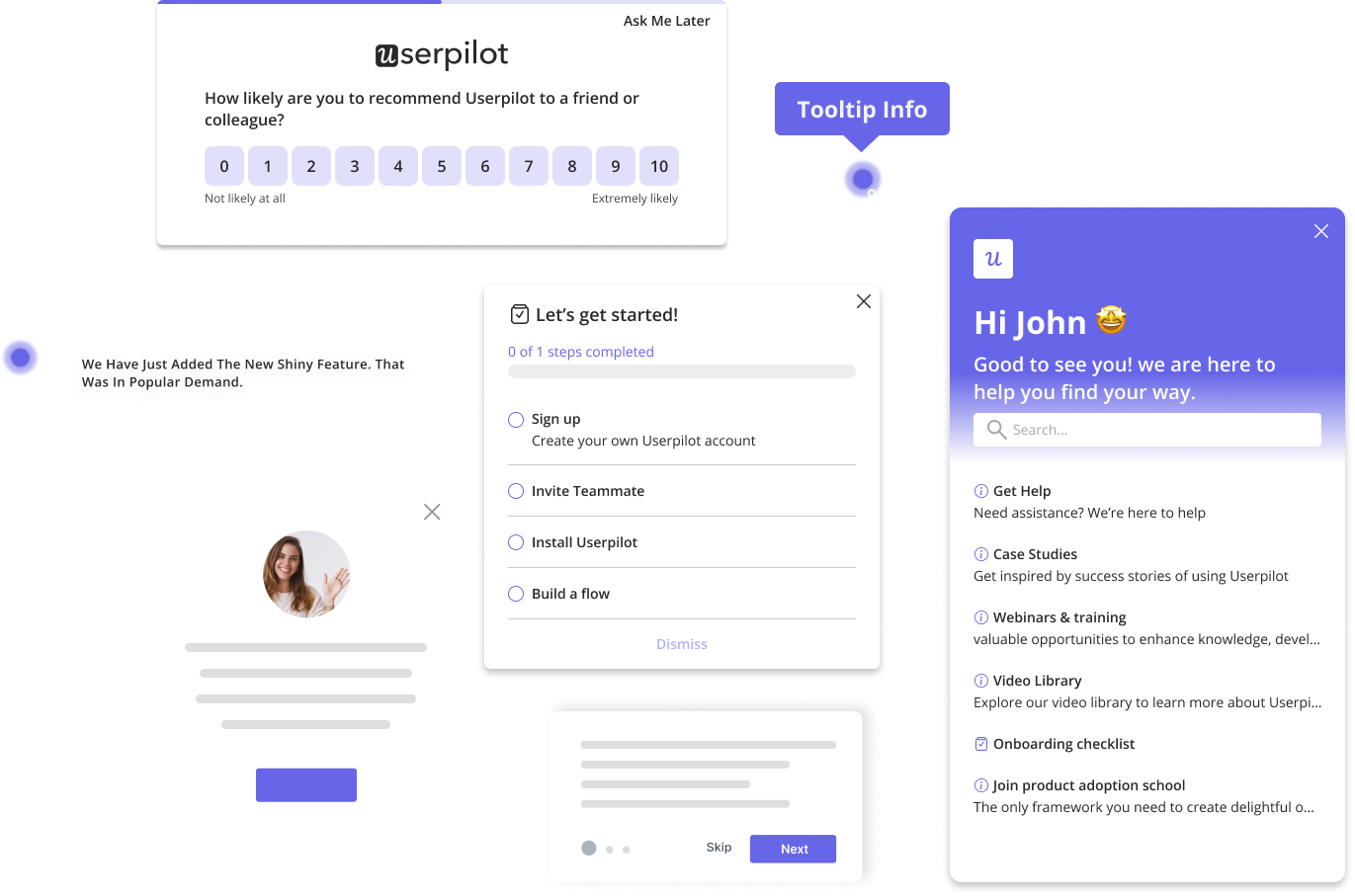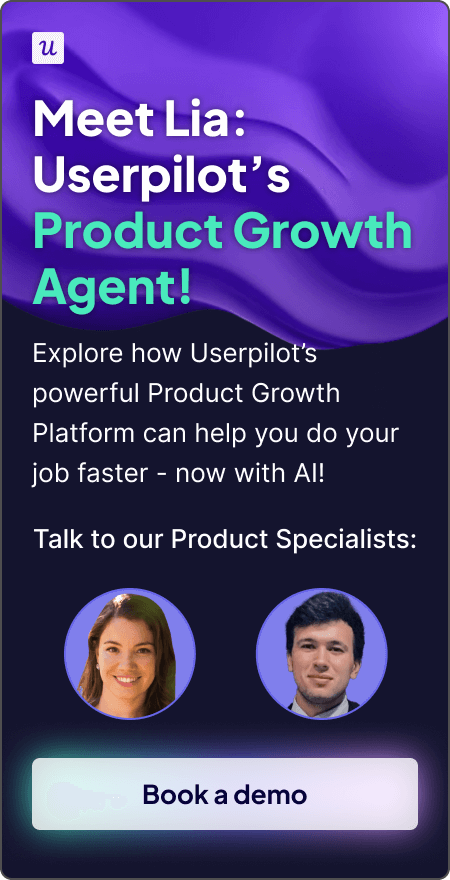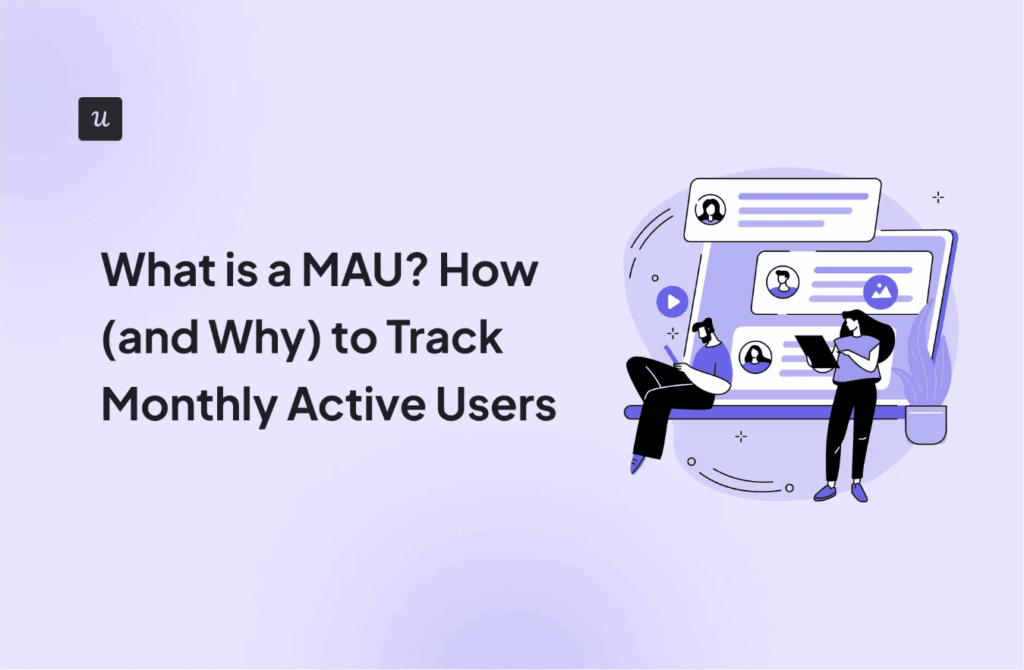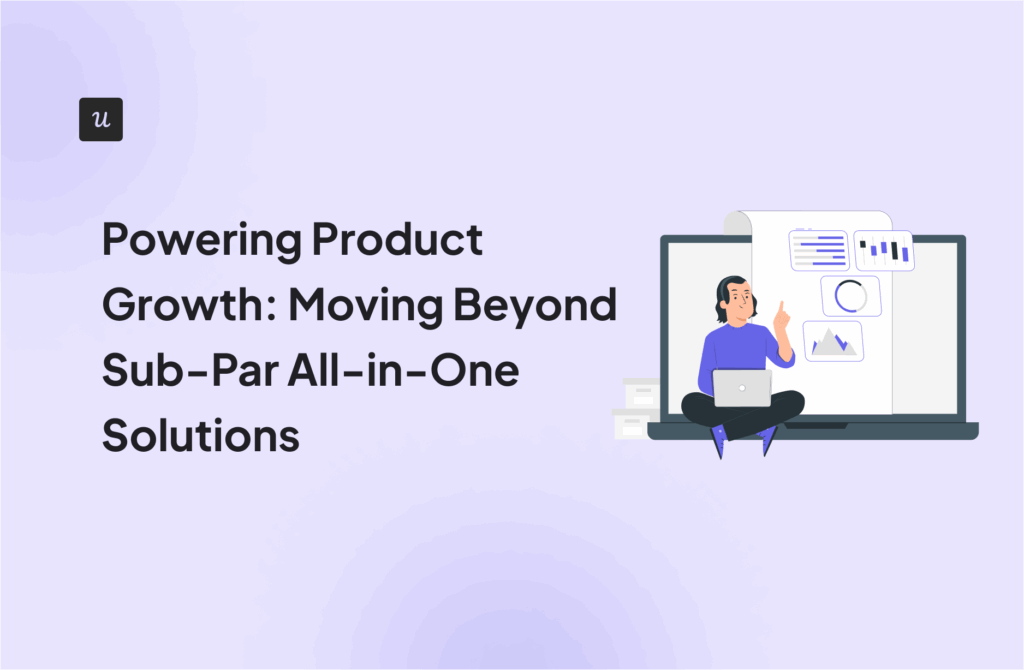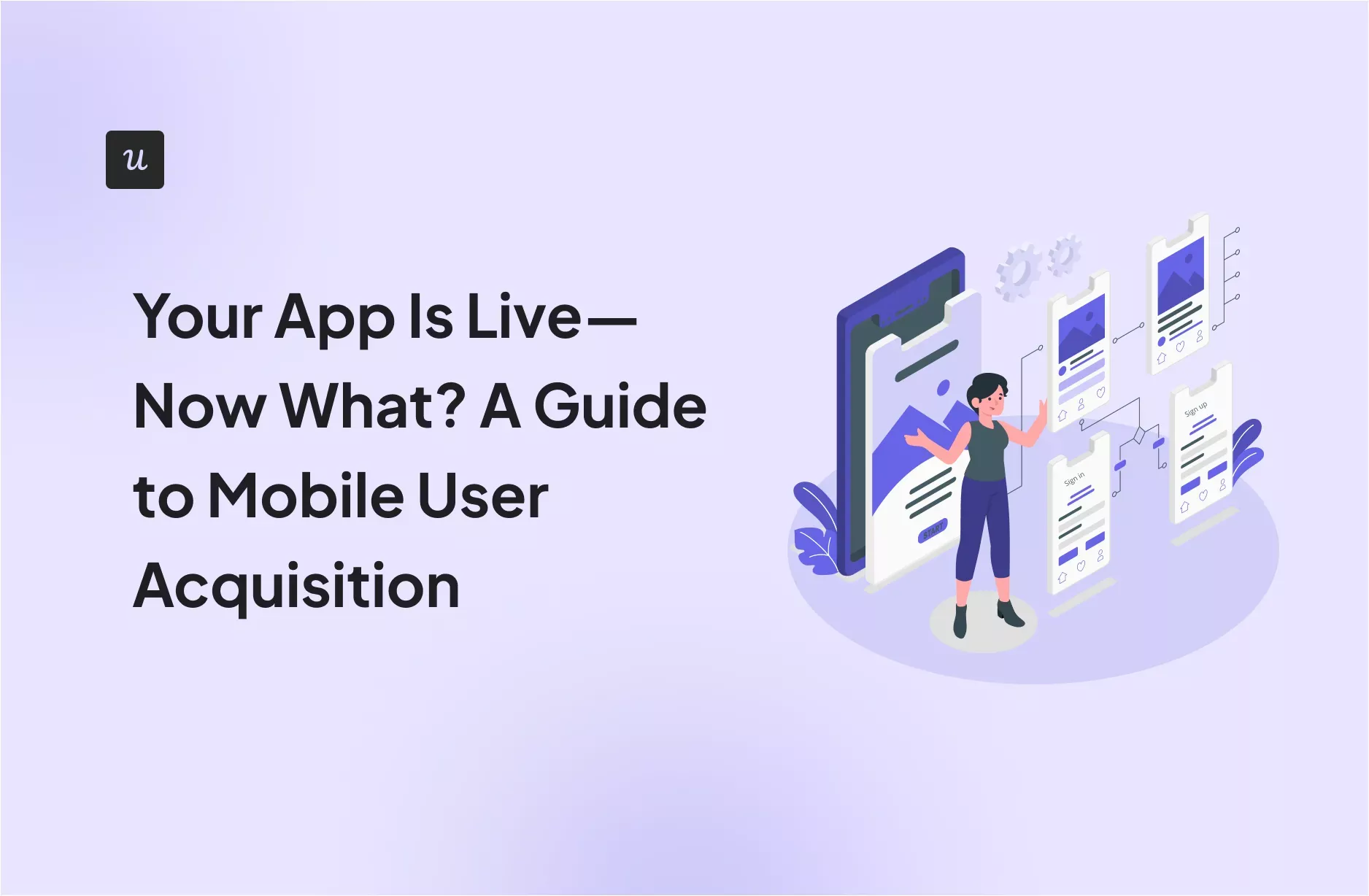
Finally, your SaaS mobile app is live! But is your mobile user acquisition strategy strong enough?
If you expect users to come naturally just because your product is good, you’re already at a disadvantage.
I say this because, despite actively supporting the product-led growth model, the mobile app market is still ridiculously competitive. Not only are there over 2 million apps in the Google Play Store, but also about 13% of business apps succeed (even less for consumer apps).
The odds are inherently against you, and without a proactive marketing strategy, you’re turning those odds into impossibilities.
So now let’s look at all the different strategies and best practices for attracting mobile users to your SaaS app:
Try Userpilot Now
See Why 1,000+ Teams Choose Userpilot
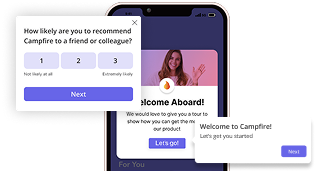
9 User acquisition strategies to scale your mobile app user base
In a nutshell, your user acquisition strategies can be either:
- Paid media marketing, where you pay platforms to put your app in front of potential users.
- Organic, when you attract users through public platforms and owned media marketing.
There are many ways to approach each, so let’s go over nine of the most effective strategies for mobile user acquisition:
1. Integrate product-led growth in your acquisition strategy
I said earlier that you shouldn’t rely on your product alone to attract mobile users.
But it doesn’t mean it’s not worth implementing product-led strategies to compel users to convert into paid customers and increase the reach of your app organically.
Some ways to approach this strategy include:
- Offering a free trial or freemium plan to allow new users to realize the value of your app before they commit to a plan.
- Use referrals to encourage users to refer your app to others.
- Ask users to leave reviews on the app store to add social proof to your app.
2. Encourage web app users to install and use your mobile app
If your app is a mobile version of a web product, then encouraging your current users to adopt your app serves as a helpful low-hanging fruit.
To do this, you can use all sorts of in-app messages such as announcements, tooltips, or banners to expose your mobile app to people who will likely find value in it.
However, there are good and bad ways to approach this tactic. If your announcement doesn’t show any value for using the mobile app, then users will see no reason to do it. This means you must consider what its purpose is in the first place, and once you’re clear on what value it brings to users, then you can better promote it to them.

For example, Slack’s mobile app allows you to balance your work with the desktop version. You can tag messages as unread to check them out later when you’re at the office, set reminders to address specific issues when you’re on the desktop, star a message, and so on.
3. Optimize app store search for greater reach
Another organic strategy is app store optimization.
Believe it or not, there are ways to optimize your app’s listing so it shows up to more users in the store (and more visibility equals more potential users).
Some of these tactics include:
- Optimizing titles and subtitles to attract the most attention from users (keywords are only necessary for the Apple store).
- Asking current users to review your app to increase trust and encourage the algorithm to display your app to more users.
- Writing convincing app descriptions that perfectly communicate the value of your app.
Learn more about app store optimization.
4. Create viral loops to optimize user acquisition
A viral loop incentivizes users to share the app with others, with some straightforward steps to implement it:
- Set up a referral program where users are rewarded for bringing in new customers.
- Design an app that naturally shows itself to non-users. E.G. a video conference tool that doesn’t require invitees to sign up (but they can see all its unique features and feel compelled to try it).
- Incentivize users to create their projects on your platform and share them so other people can experience them.
A great example of this is how Duolingo went from stagnating to achieving 350% growth in DAUs. It tried a lot of tactics like referral programs, but one of them is that it allowed volunteers to create language courses and share them with their network, creating a viral loop in the process.

5. Leverage SEO-driven content marketing
Search engine optimization (SEO), to this day, has become synonymous with organic marketing.
It not only brings high traffic to your site when done well, but it can essentially build a moat for your app business once you’ve achieved high authority.
The main problem with SEO is that it’s becoming more competitive each day. Plus, with AI summaries and zero-click searches on the rise, the share of the cake is also becoming thinner.
So instead of spamming generic, top-of-funnel content, I invite you to diversify your SEO strategy. Here are some proven strategies:
- Publish product-led content that showcases the value of your app while meeting the search intent.
- Create BoFu content early (e.g., comparison posts, product lists, reviews, etc.) since those have a higher purchase intent and can lead to quicker returns.
- Here are a few best practices to make retargeting work effectively:
- Conduct internal research to attract backlinks. You can collect data from customers or collaborate with other companies to increase your sample size.
- Build indexable free tools that are related to your app (e.g., “net present value calculator”). They tend to bring traffic with lower bounce rates and also allow visitors to try your whole product.
6. Invest in paid advertising to attract new users
Although SEO is still very profitable, it takes a lot of time to build domain authority.
That’s why you need to complement your organic marketing efforts with paid advertising. So you can get results quickly and keep the momentum going.
For a mobile app, the first move is to promote through app store search ads. For instance, you can pay to show your product when users are searching for a relevant use case (e.g. note-taking) or a competitor, just like Evernote does here:

Additionally, you can go beyond app stores, too! It’s also possible to advertise your app on social media ads (say, Facebook, LinkedIn, etc.) or on Google, so it shows up when searchers look for similar products.
7. Launch a retargeting campaign
If you’re going to invest in paid ads, retargeting is pretty much a must.
You see, not every potential user will convert the first time they come across your app. But with retargeting, you can re-engage those users who have already interacted with your brand but haven’t taken action yet.
Here are a few best practices to make retargeting work effectively:
- Segment your audience: Someone who visited your pricing page needs a different message than someone who just saw an awareness ad.
- Personalize your ads: Add dynamic content that shows users exactly what they left behind or highlight a feature that might interest them.
- Time it right: Retargeting works best when it’s neither too soon nor too late. If you retarget too aggressively, users may get annoyed. If you wait too long, they may have already moved on.
- Test different creatives: A/B test different ad formats, messaging, and visuals to see what resonates best with your audience.
- Cap ad frequency: You don’t want to overwhelm users with the same ad repeatedly. Too much exposure can have a negative effect.
8. Build a solid social media presence
A strong social media presence is one of the most effective ways to create awareness, engage with potential users, and establish credibility in your niche.
But simply posting generic content won’t cut it. Your audience is already overwhelmed with information, so you need to be intentional about what you share.
Here’s what can work for you right now:
- Engage with your community. Actively respond to comments, join relevant discussions, and participate in trending conversations.
- Leverage video content. Short explainer videos, customer testimonials, and behind-the-scenes content can help users connect with your brand.
- Repurpose user-generated content (UGC). Encourage your existing users to share their experiences with your app. Reposting reviews, case studies, and testimonials adds authenticity and social proof, making it easier to convert new users.
One standout example of a B2B SaaS company excelling at social media is Gong. Its LI posts share data-driven sales insights with catchy visuals, such as this chart showing how more reps lead to higher chances of closing a sale:

9. Partner with influencers through affiliate marketing
People trust recommendations from industry experts, niche influencers, and even their peers far more than traditional advertising.
However, when partnering with influencers who align with your target audience, you can drive highly relevant traffic to your app while leveraging the credibility they’ve already built.
This is why app marketers do influencer marketing all the time, and here’s how you can do it:
- Identify the right influencers. For B2B apps, LinkedIn influencers and YouTube thought leaders might work best. For B2C, TikTok and Instagram creators often drive the most impact.
- Offer commission-based incentives. Affiliates and influencers get rewarded per download, sign-up, or in-app purchase, ensuring they are motivated to drive high-quality users.
- Provide exclusive discounts or perks. Give influencers special promo codes, free trials, or exclusive access to premium features.
How to measure the performance of your mobile user acquisition strategy?
Launching user acquisition campaigns is just the beginning. To ensure long-term growth, you need to track key metrics that reveal what’s working and what’s not.
While there are numerous KPIs you could monitor, the following five are crucial for assessing your app’s acquisition success. They include:
- App installs conversion rate. This metric tells you how many people who saw your app listing or ad downloaded the app.
- Customer acquisition cost (CAC). Measures how much it costs to acquire a new user.
- Return on ad spend (ROAS). If you’re running paid campaigns, ROAS helps measure how much revenue your ads generate in comparison to the amount spent.
- Virality coefficient. A coefficient above 1.0 means your app has a viral loop, where each new user brings in more than one additional user. If it’s below 1.0, you may need to optimize your referral or invite system.
- Organic vs. paid acquisition ratio. This metric helps determine whether your organic efforts (SEO, content marketing, social media, referrals) are strong enough to balance paid acquisition.
Best practices for attracting new users to your app
A strong user acquisition strategy isn’t just about implementing different tactics, it’s about executing them the right way.
Below are some key best practices to maximize your acquisition efforts and convert more potential users into active customers:
Create different acquisition campaigns for different customer segments
Not all users are the same, and a one-size-fits-all approach rarely works in mobile user acquisition.
That said, tailoring your acquisition campaigns to different customer segments will significantly improve conversion rates.
Here’s how you can do it right:
- Define clear user personas based on demographics, behavior, and pain points.
- Personalize messaging based on each segment’s use case. For instance, a project management app might promote team collaboration features to startups while emphasizing security and compliance to enterprise clients.
- Target different channels based on where each segment spends time (e.g., TikTok for younger audiences, LinkedIn for B2B decision-makers).
For example, you can notice how Notion markets itself differently to students, startups, and enterprises, highlighting relevant features for each group:
Leverage social proof to build trust with potential users
Trust is a major barrier to adoption, and social proof helps overcome skepticism by showing that others have successfully used your app.
It takes work to build social proof, so here are the main channels to gather it:
- App Store reviews: Encourage happy users to leave positive reviews on the App Store and Google Play to improve credibility and discoverability.
- User testimonials and case studies: Share real success stories from users, ideally showcasing quantifiable benefits.
- User-generated content (UGC): Reshare social media posts where users showcase how they use your app.
- Industry badges and awards: If your app has been recognized on platforms like G2, Capterra, or Product Hunt, highlight these achievements.
For example, you can see how the Loom app markets itself by mentioning the sheer number of people and companies using its app. Including popular names like Hubspot, Atlassian, and Netflix.

Build a pre-launch campaign to generate buzz
The best user acquisition strategies start before your app even goes live. And for this, a pre-launch campaign can help you build an engaged audience and create anticipation.
There are many ways to approach a pre-launch campaign, but here are the basic best practices:
- Tease the launch on social media with countdowns, sneak peeks, and beta access.
- Submit your app to Product Hunt, IndieHackers, and Reddit communities for early adopters.
- Use waitlists and invite-only access to create exclusivity and drive demand.
An example of this is how Superhuman built massive hype around its email app by offering exclusive, invite-only access. This strategy created FOMO (fear of missing out) and positioned it as a premium product, leading to strong organic demand.
A/B test your messaging and visuals
User acquisition success depends heavily on how well your messaging and creatives resonate with your target audience.
To achieve this, A/B testing helps you refine your strategy based on real user behavior.
That’s why you should constantly experiment with different elements of your acquisition process, including:
- In-app messages such as tooltips, modals, and announcements.
- App stores listing elements like titles, descriptions, screenshots, and videos.
- Ad creatives (video vs. static images, different messaging angles).
- Onboarding flows such as different welcome screens or sign-up processes.
Make it easy for users to sign up
The last thing you want is to lose users at the final step due to a frustrating sign-up process. For this reason, it’s an essential best practice to ensure that your sign-up experience is frictionless and intuitive.
Here are the characteristics of a smooth sign-up page:
- Minimized form fields. Only ask for essential information such as email and name.
- Social sign-in options (Google, Apple, LinkedIn) to reduce friction. So signing up doesn’t require any typing.
- Single sign-on (SSO). Which lets users log in with a single ID.
- Smooth mobile experience. With fast loading times and intuitive UI.
Notion’s sign-up “page” is probably the best example of this. It’s just a window with minimal text, and only shows you the options you might prefer to sign in:

What happens after user acquisition? Here are your next steps
Now, if you don’t optimize your onboarding and user experience, even the most effective acquisition strategies won’t lead to sustainable growth.
Here’s what you need to focus on after acquiring new users:
Streamline onboarding to drive activation
The first few minutes after a new user installs your app are critical, this is when they decide whether it’s worth their time or not.
That’s why you must focus on designing a smooth onboarding experience inside your app. Here are some best practices for it:
- Keep it short and focused. Don’t overwhelm users with too much information at once.
- Use interactive walkthroughs. Help users learn how to use your core features by using them (instead of stale product tours).
- Highlight the ‘aha’ moment quickly. Show users the real value of your app within the first session.
If you’re worried you need to code or ask app developers to implement an onboarding process, you can use Userpilot to create an in-app onboarding experience that guides new users step by step.

Create personalized experiences to encourage habit formation
If new users fail to see how your app is particularly valuable for their unique use case, JTBDs, or pain point, they’ll eventually churn.
That’s why personalization is key. It shapes the product experience so it’s always relevant to the user’s specific needs.
Here’s how this can be done:
- Segment users based on JTBDs, goals, and stages so you can shape the app to be more useful to them. For instance, you can segment your new users to target primary onboarding flows:

- Customize the onboarding process for each segment, focusing on the best features for their main JTBDs and goals.
- Trigger different experiences such as secondary onboarding, upsell prompts, or interactive walkthroughs, based on the user’s in-app behavior.
- Send push notifications when the user is becoming too inactive or trigger contextual tooltips when the user seems to be stuck.
Ready to take your app’s growth to the next level?
A successful mobile user acquisition strategy doesn’t just follow one tactic, it leverages multiple strategies at once. How you iterate different paid and organic methods will depend on your app and target users.
However, to build a sustainable SaaS business, you need to actively engage and retain users too.
For that, Userpilot’s no-code onboarding and engagement tools are probably the best option for non-technical product teams who also need to increase activation rates, personalize user journeys, and drive long-term retention.
Want to see how Userpilot can help you elevate your app experience? Book a free demo today.
FAQ
What is mobile user acquisition?
Mobile user acquisition is the process of attracting new users to adopt your mobile app through different marketing strategies and channels. It can involve both organic (e.g., SEO) and paid user acquisition strategies and requires active investment to keep more users flowing in rather than out of the app.
What are some common challenges when acquiring users?
Acquiring users for a mobile app comes with several obstacles. Some of the most common challenges include:
- High competition. With millions of apps in the app stores, standing out is difficult.
- User skepticism. Many users hesitate to try new apps unless there’s strong social proof.
- Ad fatigue. Potential users may become desensitized to repetitive ads, making it harder to convert them.
- High customer acquisition costs (CAC). Paid ads can quickly become expensive if campaigns are not optimized.
- Low retention rates. Many users download apps but abandon them after a single session.
What is a good user acquisition cost?
User acquisition cost varies widely based on industry, app category, and acquisition channel. This means there’s no single digit that can count as “good” or “bad.”
However, you can compare your acquisition costs with different CAC benchmarks, including:
- $236 for B2B SaaS.
- $274 for e-commerce.
- $1,450 for fintech.
- $387 for cybersecurity.
- $560 for ad tech.




